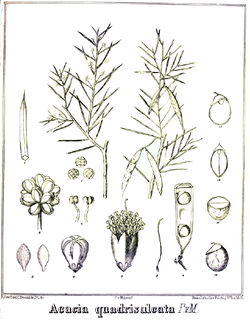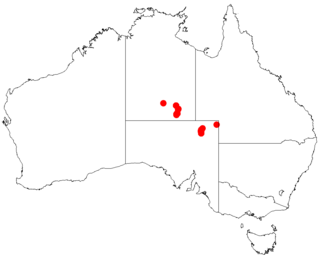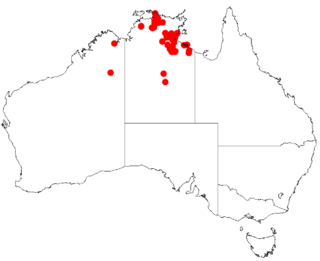
Acacia verticillata is a perennial shrub to small tree native to south eastern Australia.

Acacia maitlandii, also known as Maitland's wattle, is a perennial tree native to Australia.

Acacia notabilis, known colloquially as mallee golden wattle, Flinders wattle or stiff golden wattle, is a species of Acacia native to Australia.

Acacia adoxa, commonly known as the grey-whorled wattle, is a species of plant in the legume family that is native to northern Australia.

Acacia stipuligera is a tree or shrub belonging to the genus Acacia and the subgenus Juliflorae. It is native to arid and tropical parts of northern Australia.

Acacia anasilla is a shrub belonging to the genus Acacia and the subgenus Lycopodiifoliae that is endemic to north western Australia.

Acacia asperulacea is a shrub belonging to the genus Acacia and the subgenus Lycopodiifoliae.

Acacia capillaris is a shrub belonging to the genus Acacia and the subgenus Lycopodiifoliae that is endemic to small area in north western Australia.

Acacia hippuroides is a shrub belonging to the genus Acacia and the subgenus Lycopodiifoliae that is endemic to north western Australia

Acacia leptospermoides is a shrub belonging to the genus Acacia and the subgenus Phyllodineae and is endemic to a large area of south western Australia.

Acacia quadrisulcata is a shrub of the genus Acacia and the subgenus Phyllodineae endemic to Western Australia.

Acacia rossei, also known as Yellowdine wattle, is a shrub of the genus Acacia and the subgenus Phyllodineae that is endemic to south western Australia.

Acacia simulans is a shrub of the genus Acacia and the subgenus Phyllodineae that is endemic to south western Australia.

Acacia sphacelata is a shrub of the genus Acacia and the subgenus Phyllodineae that is endemic to south western Australia.

Acacia phlebocarpa, also known as tabletop wattle, is a shrub of the genus Acacia and the subgenus Plurinerves and is native to northern Australia.

Acacia stipulosa is a shrub of the genus Acacia and the subgenus Plurinerves that is endemic to area area of northern Australia.

Acacia trineura, known colloquially as three-nerve wattle or three nerved wattle or green wattle, is a species of Acacia native to south eastern Australia.

Acacia pickardii, commonly known as Pickard's wattle or birds nest wattle, is a tree or shrub belonging to the genus Acacia and the subgenus Phyllodineae native to eastern Australia. It is listed as a vulnerable species according to Environment Protection and Biodiversity Conservation Act 1999.

Acacia conspersa is a shrub or tree belonging to the genus Acacia and the subgenus Juliflorae that is native to northern Australia.

Acacia rhigiophylla, commonly known as dagger-leaf wattle, is a shrub belonging to the genus Acacia and the subgenus Juliflorae that is native to southern Australia.




















